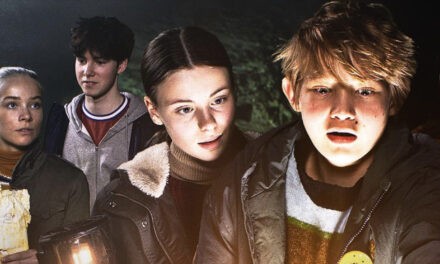In 2010, Michele Byers and David Lavery published the book On the Verge of Tears: Why Movies, Television, Music, Art, Popular Culture, Literature and the Real World Make us Cry (Cambridge University Press). The essays included in this book offer personal reflections on those moments within our every day lives which cause tears to flow and they invite similar reflection from their readers. Reading some of the entries in this book, I was inspired to reflect on those films and television programmes that made me cry. Contenders included the conclusion to the seasonal favourite It’s a Wonderful Life (Frank Capra 1946) as the entire community of Bedford Falls come to the rescue of the much loved George Bailey; Atticus Finch’s silent departure from the court house after having lost his defence of Tom Robinson in To Kill a Mockingbird (Robert Mulligan 1962) ; and virtually the last thirty minutes of Make Way for Tomorrow (Leo McCarey 1937), described by Orson Wells as the saddest film ever made.
For me, television yields many more such moments including the finales of Buffy, Angel, and Alias; Buffy (Sarah Michelle Geller) receiving the class protector award at her high school prom (‘The Prom’ 3:20); the death of Mrs Landingham (Kathryn Joosten) and President Bartlett’s (Martin Sheen) diatribe to God in The West Wing’s ‘Two Cathedrals’ (2.22); Donna Noble’s (Catherine Tate) painful departure from Doctor Who (‘Journey’s End’ 4:13)  and werewolf George (Russell Tovey) ‘saving’ his vampire best friend Mitchell (Aidan Turner) by staking him through the heart in Being Human (‘The Wolf-Shaped Bullet’ 3:8). These moments, along with my tears, stand as a testament to my emotional investment in these complex dramas and to the capacity of television to capture the best and worst of humanity and being human.
and werewolf George (Russell Tovey) ‘saving’ his vampire best friend Mitchell (Aidan Turner) by staking him through the heart in Being Human (‘The Wolf-Shaped Bullet’ 3:8). These moments, along with my tears, stand as a testament to my emotional investment in these complex dramas and to the capacity of television to capture the best and worst of humanity and being human.
In recent years, however, no television show has brought forth as many tears from me as what must seem to be one of the least likely candidates, The Walking Dead. A zombie TV series making you cry? What is wrong with this picture? The zombie film/series is supposed to be a splatter genre designed to incite horror, disgust and, at best, despair. Even the death of Ben (Duane Jones), the ‘hero’ of George Romero’s Night of the Living Dead (1968) who dies at the hands of the militia who promised rescue, does not generate tears but rather a sombre silence expressing the inhumanity of humanity. Adam Lowenstein describes the experience of this moment as ‘devastating’ (American Nightmare Adam Simon 2000) and indeed it is, but it does not make me cry. Zombie franchises such as the Resident Evil films, the 28 Days Later films, and Romero’s many entries in his Living Dead series, offer the action spectacle of the fight for survival alongside the visual destruction of the body in the most dehumanising way. Victims of zombie attacks are often presented as disposable –zombie fodder to escalate the genre’s required body count– and the pacing of the films demand that the audience does not dwell on character death but, like the other survivors, moves on to confront the next obstacle be it zombie or human. This is not a negative criticism as the zombie film is designed to generate horror, confronting us with a monstrous apocalyptic vision.
The Walking Dead equally presents an apocalyptic vision featuring the required spectacle of the destruction of the body and the fight for survival. In addition it produces overwhelming jaw-dropping moments of bleakness and despair, including Shane’s (Jon Berthnal) shocking sacrifice of Otis (Pruitt Taylor Vince) in order to escape the high school zombie attack (‘Save the Last One’ 2:3) and the emergence of the missing child Sophia (Madison Lintz) from Hershel’s (Scott Wilson) barn, now revealed as a zombie.

(‘Pretty Much Dead Already’ 2: 7).
This moment confirms, in the most monstrous fashion, the group’s suspicions that their search has been in vain for she is in fact dead, bringing home the horror that underpins all stories of missing children for she is the walking embodiment of the dead child. The emotional impact of this scene is accentuated by the blood bath that surrounds this revelation as Shane dispassionately disposes of the other zombies with little regard for Hershel and the others, for whom these zombies are in fact family. That is until Sophia’s emergence when Shane’s blood bath turns to personal tragedy for our group, as he and the others are forced to confront their own loss, reminding them and the audience that the loss of loved ones awaits us all.
In addition to generating feelings of shock and horror through such moments, however, The Walking Dead has caused me to weep unreservedly during two key scenes (season 2 and 3 spoilers ahead): the death of Dale (Jeffrey DeMunn) eviscerated by zombies in season 2 (‘Judge Jury and Executioner’ 2:11) and Lori (Sarah Wayne Callies), who recently died in childbirth in season 3 (‘Killer Within’ 3:4). This is not simply the result of the loss of characters with which we are emotionally invested as I did not respond in the same way when either Amy (Emma Bell) or T-Dog (IronE Singleton) died, despite having invested to varying degrees in both characters. Both of their deaths were sudden, occurring in the middle of a more sustained zombie attack and their loss was expressed more as a symptom of the hopelessness of the human situation within the context of a zombie apocalypse. These sequences were far more in keeping with traditions within the zombie film, where the deaths of characters occur quickly and efficiently such as when infected blood drips into Brendan Gleason’s eye in 28 Days Later and he is subsequently killed at the hands of the military just as the rage threatens to overcome him.
In contrast, Dale and Lori’s death scenes capture the slow, drawn out and painful demise of much loved characters. The damage to Dale’s body is not made a spectacle in traditional zombie fashion but rather serves a reminder of the vulnerability of the body as he struggles to stay alive, accentuated by the painful sounds of his laboured breathing. The quick demise of Lori, once the caesarean incision is made, highlights the speed with which life can slip away . These are powerful moments that confront us with the harsh reality of death and the fragility of life. Furthermore, in both scenes the characters are surrounded by their loved ones, a mise-en-scene that powerfully evokes the death bed vigil and focuses upon their suffering as they are confronted by loss and the difficult decisions that come with loss, such as the need to put Dale out of his misery. Of course this act does prevent him from coming back as a zombie but here the emphasis is upon the act of mercy rather than self-protection. Carl’s (Chandler Riggs) off-screen shooting of Lori to prevent her reanimation captures the child’s forced confrontation with the death of a parent and their immediate transition to adulthood. Through my tears, I was struck by the fact that beneath the veneer of horror both scenes offered a powerful evocation of the trauma of death, not on the victim but on those left behind. The trauma and helplessness of those left to make sense of loss and the horror of death itself as evidenced by Rick’s response to Lori’s death.
slip away . These are powerful moments that confront us with the harsh reality of death and the fragility of life. Furthermore, in both scenes the characters are surrounded by their loved ones, a mise-en-scene that powerfully evokes the death bed vigil and focuses upon their suffering as they are confronted by loss and the difficult decisions that come with loss, such as the need to put Dale out of his misery. Of course this act does prevent him from coming back as a zombie but here the emphasis is upon the act of mercy rather than self-protection. Carl’s (Chandler Riggs) off-screen shooting of Lori to prevent her reanimation captures the child’s forced confrontation with the death of a parent and their immediate transition to adulthood. Through my tears, I was struck by the fact that beneath the veneer of horror both scenes offered a powerful evocation of the trauma of death, not on the victim but on those left behind. The trauma and helplessness of those left to make sense of loss and the horror of death itself as evidenced by Rick’s response to Lori’s death.
Nowhere have I seen a moment on television or elsewhere that better captures the horror of grief. Rick’s (Andrew Lincoln) emotional response stands in stark contrast with the Governor’s (David Morrissey) denial of grief, refusing to accept the infection/death of his daughter Penny (Kyle Szymanski). Rather than confront the grief like Rick, the Governor keeps Penny tied up in a sad attempt to hold onto his child, feigning normality by brushing her hair and hugging her, ignoring her monstrous snarls and attempts to bite him.

But even he must confront loss when Penny is eventually disposed of by Michonne (Danai Gurira) and the Governor collapses into bloody tears as he cradles the body of his long dead child (‘Made to Suffer’ 3: 8). The Walking Dead offers the roller coaster ride of the zombie film alongside a powerful social commentary about the dark side of humanity when put to the test but amidst the blood, guts, and body parts are tears as the series offers an evocative exploration of trauma, grief and mourning.
Stacey Abbott is a Reader in Film and Television Studies at the University of Roehampton. She is the author of Celluloid Vampires (2007) and Angel: TV Milestone (2009), and co-author, with Lorna Jowett, of TV Horror: Investigating the Dark Side of the Small Screen (forthcoming 2012). She is also the editor of The Cult TV Book (2010) and General Editor of the Investigating Cult TV series at I.B. Tauris.





